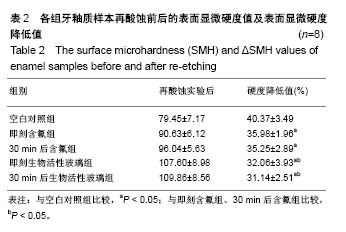| [1] 陈亚刚,李雪,胡德渝,等.徐州市5岁和12岁儿童酸蚀症调查研究[J].华西口腔医学杂志,2009,7(5):565-567.[2] 曾晓娟,黄华,吴卫,等.广西 3~5岁儿童牙齿酸蚀症的流行情况调查[J].广西医科大学学报,2008,25(5):812-814.[3] Arnadottir IB,Holbrook WP,Eggersson H,et al.Prevalence of dental erosion in children:A national survey.Community Dent Oral Epidemiol.2010;38(6):521-526.[4] Hasselkvist A,Johansson A,Johansson AK.Association between soft drink consumption, oral health and some lifestyle factors in Swedish adolescents.Acta Odontol Scand. 2014;72(8):1039-1046.[5] Ryu HK,Kim YD,Heo SS,et al.Effect of carbonated water manufactured by a soda carbonator on etched or sealed ename Effect of carbonated water manufactured by a soda carbonator on etched or sealed ename. Korean J Orthod. 2018;48(1):48-56.[6] Al-Dlaigan YH,Al-Meedania LA,Anil S.The influence of frequently consumed beverages and snacks on dental erosion among preschool children in Saudi Arabia.Nutr J. 2017;16(1):80.[7] Mascarenhas AK.Risk factors for dental fluorosis: A review of the recent literature.Pediatr Dent.2000;22(4):269-277.[8] Burwell AK,Litkowski LJ,Greenspan DC.Calcium sodium phosphosilicate (Bioactive glass): Remineralization potential. Adv Dent Res.2009;21(1):35-39.[9] Du Min Q,Bian Z,Jiang H,et al.Clinical evaluation of a dentifrice containing calcium sodium phosphosilicate (bioactive glass) for the treatment of dentin hypersensitivity.Am J Dent.2008;21(4):210-214.[10] Earl JS,Leary RK,Muller KH,et al.Greenspan DC.Physical and chemical characterization of dentin surface following treatment with Bioactive glass technology.J Clin Dent. 2011;22(3):62-67.[11] Kanzow P,Wegehaupt FJ,Attin T,et al.Etiology and pathogenesis of dental erosion. Quintessence Int. 2016;47(4): 275-278.[12] Lussi A,von Salis-Marincek M,Ganss C,et al.Clinical Study Monitoring the pH on Tooth Surfaces in Patients with and without Erosion.Caries Res.2012;46:507-512.[13] Mendonça FL,Jordão MC,Ionta FQ,et al.In situ effect of enamel salivary exposure time and type of intraoral appliance before an erosive challenge.Clin Oral Investig. 2017;21(8): 2465-2471.[14] Carvalho TS,Baumann T,Lussi A.In vitro salivary pellicles from adults and children have different protective effects against erosion.Clin Oral Investig.2016;20(8):1973-1979. [15] Alencar CR,Mendonça FL,Guerrini LB,et al.Effect of different salivary exposure times on the rehardening of acid-softened enamel.Braz Oral Res.2016;30(1):e104.[16] Denucci GC,Mantilla TF,Amaral FLB,et al.Saliva with reduced calcium and phosphorous concentrations: Effect on erosion dental lesions. Oral Dis.2018.doi:10.1111/odi.12843.[17] Zwier N,Huysmans MC,Jager DH,et al.Saliva parameters and erosive wear in adolescents.Caries Res. 2013;47(6):548-552. [18] Ericson D,Bratthall D.Simplified method to estimate salivary buffer capacity.Dent Res.1989; 97(5):405-407. [19] 陈亚刚,胡德渝.唾液检测用于龋病风险性评估的研究进展[J].中华口腔医学研究杂志(电子版),2008,2(1):75-78.[20] Baumann T,Kozik J,Lussi A,et al.Erosion protection conferred by whole human saliva, dialysed saliva, and artificial saliva. Sci Rep.2016;6:34760.[21] Buzalaf MA,Hannas AR,Kato MT.Saliva and dental erosion.J Appl Oral Sci.2012;20(5):493-502.[22] Delvar A,Lindh L,Arnebrant T,et al.Interaction of Polyelectrolytes with Salivary Pellicles on Hydroxyapatite Surfaces under Erosive Acidic Conditions.ACS Appl Mater Interfaces.2015;7(38):21610-21618.[23] Nekrashevych Y,Hannig M,Stsser L.Assessment of enamel erosion and protective effect of salivary pellicle by surface roughness analysis and scanning electron microscopy.Oral Health Prev Dent.2004;2(1):5-11. [24] Mutahar M,Carpenter G,Bartlett D,et al.The presence of acquired enamel pellicle changes acid-induced erosion from dissolution to a softening process.Sci Rep.2017;7(1):10920. [25] Nekrashevych Y,Hannig M,Stsser L.Assessment of enamel erosion and protective effect of salivary pellicle by surface roughness analysis and scanning electron microscopy.Oral Health Prev Dent. 2004;2(1):5-11. [26] 王松龄.涎腺非肿瘤疾病[M].北京:科学技术文献出版社, 2001: 34-35. [27] Scaramucci T,Borges AB,Lippert F,et al.Sodium fluoride effect on erosion-abrasion under hyposalivatory simulating conditions.Arch Oral Biol.2013;58(10):1457-1463. [28] Zhang Y,Chong Y,Huang RZ.Effect of topical iron, fluoride application on eroded enamel in vitro. Shanghai Kou Qiang Yi Xue.2016;25(2):168-171.[29] Medeiros IC,Brasil VL,Carlo HL,et al.In vitro effect of calcium nanophosphate and high-concentrated fluoride agents on enamel erosion: an AFM study.Int J Paediatr Dent. 2014; 24(3):168-174.[30] João-Souza SH,Lussi A,Baumann T,et al.Chemical and physical factors of desensitizing and/or anti-erosive toothpastes associated with lower erosive tooth wear.Sci Rep.2017;7(1):17909.[31] Apleton J.Formation and structure of dentine in the rat incisor after chronic exposure to sodium fluoride.Scanning Microsc. 1994;8(3):711-719. [32] 姜达君,贾伟涛.张长青生物玻璃在骨修复中的研究进展[J].中国修复重建外科杂志,2017,31(12):1512-1516.[33] Rahaman MN,Day DE,Sonny Bal B,et al.Bioactive glass in tissue engineering.Acta Biomater. 2011;7(6):2355-2373. [34] Baino F,Hamzehlou S,Kargozar S.Bioactive Glasses: Where Are We and Where Are We Going?J Funct Biomater. 2018;9(1).pii: E25.doi: 10.3390/jfb9010025.Review.[35] Zhong Y,Liu J,Li X,et al.Effect of a novel bioactive glass-ceramic on dentinal tubule occlusion: an in vitro study.Aust Dent J.2015;60(1):96-103.[36] Bakry AS, Marghalani HY, Amin OA, et al. The effect of a bioglass paste on enamel exposed to erosive challenge. J Dent. 2014;42(11):1458-1463.[37] Ramashetty Prabhakar A,Arali V.Comparison of the remineralizing effects of sodium fluoride and bioactive glass using bioerodible gel systems.J Dent Res Dent Clin Dent Prospects.2009;3(4):117-121. [38] Vichery C,Nedelec JM.Bioactive Glass Nanoparticles: From Synthesis to Materials Design for Biomedical Applications. Materials (Basel).2016;9(4).pii: E288.doi: 10.3390/ma9040288.[39] 赵玉龙,杨德圣.生物活性玻璃抑制酸蚀后不同时间牙釉质的刷牙磨损[J].中国组织工程研究,2015,19(25):4022-4026. |
.jpg)




.jpg)